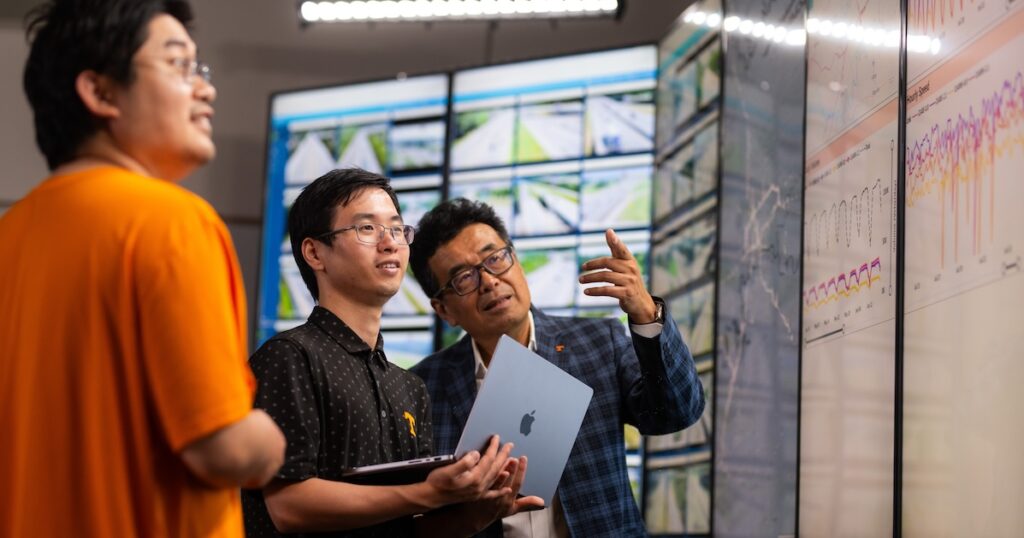As you drive to the beach this summer, you may find yourself playing road trip games based on the license plates around you. How many states’ plates do you see? How many different animals can you find? Can you find a plate in every color of the rainbow?
Can you write an algorithm that recognizes, distinguishes, and accurately reads all those plates?
That last game may silence your car conversation for a bit, but Professor Lee Han, an expert in transportation and traffic engineering, spent years playing it.
“The US has more than 3,000 different license plate designs,” said Han. “These designs feature different fonts, logos, color schemes, reflectivity, and sometimes double or triple-stacked letters.”
While automated license plate recognition (LPR) technology has been in development since the 1970s, human verification is often still required for open road tolling, speed enforcement, parking control, and other traffic services in the US. This limits the efficacy of the intelligent transportation system (ITS)–the network of cameras, sensors, and other technologies that allow transportation authorities to monitor and manage the flow of traffic. Plate recognition is especially difficult on highways, where cars can be traveling at over 70 miles per hour.
Han has been working with the Tennessee Department of Transportation (TDOT) for more than a decade to improve the state’s LPR capabilities, focusing on improvements that can be layered onto existing components of the ITS.
Machine Learning LPR Advances Accuracy—and Careers
In 2011, Han and his graduate students oversaw twelve undergraduates as they created a new, machine learning (ML)-based algorithm that can be layered onto off-the-shelf LPRs to track individual vehicles.
One of those undergrads, James Ensley III (BS ‘11, MS ‘12), had always enjoyed puzzles but never considered traffic or license plate reading to be one of them.
“You sit in traffic every day, but you have no idea what’s behind it,” Ensley said. “As I worked on the LPR project, traffic kept getting more important and more interesting.”
Han encouraged the undergrads on the team to chase their evolving interests.

“I try to give my undergraduate students creative control when I can,” Han said. “A lot of students coming up from a standardized school system are used to being told what to do. They need a lot of encouragement and coaxing to say what they want to do.”
For his part, Ensley wanted to be a civil engineer. He went on to earn his master’s degree under Han’s advisement and is now a professional traffic engineer at T-Square Engineering, Inc., a civil engineering firm based in Franklin, TN.
“The LPR project heavily impacted my career,” Ensley said. “It taught me how to better understand things from a theoretical standpoint, how to solve problems by knowing where and how to look for information. I am still doing work related to what I did with Dr. Han.”
By the time the project ended, the team of undergraduates had created an ML agent that can identify and track license plates with over 98% accuracy.
A Fair Share of the Fuel Tax
Years later, Han and his PhD student Harry Zhang are implementing the ML-LPR system to address a much more specialized problem: getting Tennessee a fair share of federal funds.
The federal fuel tax, applied at the point of sale, helps fund many states’ infrastructure projects. However, thanks to their large diesel tanks, freight trucks often drive through multiple states without refueling.
“Tennessee has eight neighboring states, so a lot of traffic comes through here, but most of those vehicles buy their fuel before entering the state,” Han said. “Even though those trucks are driving on Tennessee roads, if their logs are inaccurate, we don’t get the correct proportion of their fuel tax dollars.”

Zhang and Han determined that applying Han’s advanced LPRs to weigh stations, which automatically take license plate photos, would let them track freight trucks through Tennessee—not only identifying their origins, but measuring how many miles they drive in the state.
Tennessee could then petition the federal government for a portion of the gas tax that corresponds to the state’s actual traffic density, increasing its budget for transportation infrastructure.
Before they could gather the data, the team had to add another layer to the ML-LPR, instructing it to only track trucks—not camper vans, horse trailers, or other large vehicles. They also had to make that distinction in other ITS tools, like the loop detectors that help researchers estimate traffic volume on highways.
A Comprehensive Freight Framework
Zhang and Han not only relished the complexity of the problem, but expanded upon it, creating a system that can accurately track freight trucks and report the number of trucks on different highways in a state throughout the day.
“We’re establishing a comprehensive framework for estimating truck volume at enhanced temporal and spatial resolution,” Zhang said. “In addition to increasing Tennessee’s federal funding, this will help us understand how freight traffic responds to different kinds of incidents and disruptions in the network.”
Going beyond the initial scope of a project is something Han encourages all of his graduate students to try.
“I tell my students that the purpose of PhD research is to create new knowledge,” he said. “This is the time to get creative and challenge what’s been established.”
Long-running projects like the continual advancement of Han’s LPR systems allow current students to build on the discoveries of their predecessors. In another decade, Zhang’s freight-tracking work could be applied to a problem that hasn’t yet been identified.
“It’s a real honor to join Dr. Han’s research team and to be involved in a well-established project like this one,” Zhang said. “It’s a great challenge and opportunity to keep making innovations on top of what has been done previously.”
Contact
Izzie Gall (865-974-7203, egall4@utk.edu)
